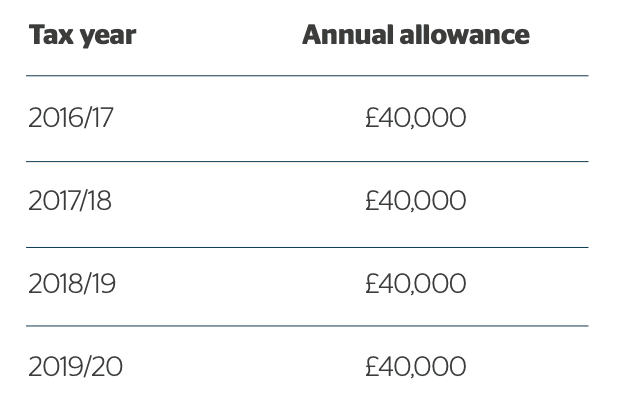TIME TO GIVE YOUR PENSION POT A BOOST?
Planning ahead for the financial future you want
Planning for retirement can be both exciting and daunting. It’s essential to structure your affairs to make sure you have enough money when you eventually retire.
To give your pension pot a boost, one option to consider if your pension savings are more than your annual allowance is to take advantage of the ‘carry forward’ rules for unused annual allowances from previous years and still receive tax relief.

TO TAKE ADVANTAGE OF CARRY FORWARD RULES, YOU MUST MAKE THE MAXIMUM ALLOWABLE CONTRIBUTION IN THE CURRENT TAX YEAR (£40,000 IN 2019/20). YOU CAN THEN CARRY FORWARD ANY UNUSED ANNUAL ALLOWANCES FROM THE THREE PREVIOUS TAX YEARS.
The carry forward rules were introduced from 6 April 2011 and allow your unused annual allowance to be carried forward from the three previous tax years. Where this can be very beneficial is for an individual who has received a large salary increase, whose profits have been good in a self-employed business, who has been made redundant or who is nearing retirement.
VERY USEFUL FOR HIGH EARNERS
Utilising carry forward can also be very useful for high earners who are affected by the tapered annual allowance, which was introduced in April 2016. The way the tapered annual allowance works is that anyone with an adjusted income of more than £150,000 per year has their annual allowance reduced by £1 for every £2 they earn over £150,000, up to a maximum reduction of £30,000. To be able to carry forward unused annual allowance from a previous tax year, you must have been a member of a registered pension scheme at some point in that tax year (a ‘member’ includes active, deferred and pensioner members). This can apply even if no contributions were made during that year or if there was a nil pension input amount.
MAXIMUM ALLOWABLE CONTRIBUTION
To take advantage of carry forward rules, you must make the maximum allowable contribution in the current tax year (£40,000 in 2019/20). You can then carry forward any unused annual allowances from the three previous tax years. The amount of annual allowance that you can carry forward will depend on how much of your annual allowance you used in the previous three tax years. When assessing how much of your annual allowance you used in previous tax years, you need to include the total value of the contributions you made to your pension, any contributions made by your employer, and the tax relief you received from HMRC.

AUTOMATICALLY CARRY FORWARD ANY UNUSED ANNUAL ALLOWANCE
Carry forward cannot be used for any year that an individual was not a member of a registered pension scheme. It’s also worth noting that any contribution made using carry forward does not need to be made to the same registered pension scheme that an individual was a member of in the previous year. It’s possible to carry forward any unused annual allowance automatically. There’s no requirement to make a claim to HMRC to carry forward any unused allowance, and there’s no need for the details to be included on a self-assessment tax return if there’s no annual allowance charge due. From 6 April 2015, the Money Purchase Annual Allowance (MPAA) was introduced. This reduced the annual allowance in certain circumstances. An individual cannot utilise carry forward if they have triggered the MPAA (unless they have ongoing accrual in a defined benefit scheme).
ARE YOU ON TRACK FOR YOUR RETIREMENT?
To discuss your position, please contact us.
ACCESSING PENSION BENEFITS EARLY MAY IMPACT ON LEVELS OF RETIREMENT INCOME AND YOUR ENTITLEMENT TO CERTAIN MEANS TESTED BENEFITS AND IS NOT SUITABLE FOR EVERYONE. YOU SHOULD SEEK ADVICE TO UNDERSTAND YOUR OPTIONS AT RETIREMENT.
INFORMATION IS BASED ON OUR CURRENT UNDERSTANDING OF TAXATION LEGISLATION AND REGULATIONS. ANY LEVELS AND BASES OF, AND RELIEFS FROM, TAXATION ARE SUBJECT TO CHANGE.
TAX RULES ARE COMPLICATED, SO YOU SHOULD ALWAYS OBTAIN PROFESSIONAL ADVICE.
A PENSION IS A LONG-TERM INVESTMENT.
THE FUND VALUE MAY FLUCTUATE AND CAN GO DOWN, WHICH WOULD HAVE AN IMPACT ON THE LEVEL OF PENSION BENEFITS AVAILABLE. PAST PERFORMANCE IS NOT A RELIABLE INDICATOR OF FUTURE PERFORMANCE.
PENSIONS ARE NOT NORMALLY ACCESSIBLE UNTIL AGE 55. YOUR PENSION INCOME COULD ALSO BE AFFECTED BY INTEREST RATES AT THE TIME YOU TAKE YOUR BENEFITS. THE TAX IMPLICATIONS OF PENSION WITHDRAWALS WILL BE BASED ON YOUR INDIVIDUAL CIRCUMSTANCES, TAX LEGISLATION AND REGULATION, WHICH ARE SUBJECT TO CHANGE IN THE FUTURE

